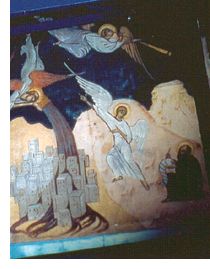 It was the happiest day of my life. Thus it was that 'Sister' Joanna made her appearance. And, indeed, her art became her most important spiritual achievement. It was the happiest day of my life. Thus it was that 'Sister' Joanna made her appearance. And, indeed, her art became her most important spiritual achievement.
Evidently, sister Joanna drew from her earliest childhood. At school, she was nicknamed 'Reitlinger - the artist'. Her entry into the school of the Society for the Advancement of Artists was a kind of realisation of that nickname. We do not know whether Yu. N. Reitlinger worked as an artist in the Crimea 1917-21, but drawings and watercolours from her Prague and Belgrade periods (1922-24) have survived. They testify to the taste of a young artist both in the turn of the century aesthetic 'World of Art' movement and the romantic images of the European Middle Ages. The majority of the drawings were done - when she had already become Sister Joanna - and later, in part, in the outskirts of Paris. They as well as the illustrations for children's books in the 1930's and 40's, bear witness to her unceasing love for 'our lesser brethern'. Animals possess a spirituality and appeal, a limited humanity. It is no accident that one of her best loved subjects of later years was 'All that hath breath...'
What could Yu. N. Reitlinger see in her childhood and early youth from examples of icon-painting, which thereby had such an influence on her spiritual stirrings ? We do not know whether she was at two major exhibitions in 1911 and 1913 . However, she took certain impressions away with her from Petersburg.
In emigration she kept the best publication of those years of old Russian paintngs, the 6th volume of the 'History of Russian Art' by Igor Grabar (1914) with wonderful illustrations by P.P Muratov . The question of a renaissance of the tradition of religious art in pre-revolutionary Russia boiled down to a contrast between the living Old Believer tradition and modern art. We know that the technology of Old Believer icons was closely studied by Yu. N. Reitlinger. However, she ruled out going down the path of the purely automatic practice of tracing ('It wasn't my way'). Attempts at reviving the tradition of Old Russian within the branches of the modern style did not suit her either. Evidence of this is her quite harsh comment on the work of D. S. Stelletski (1875-1977) in her autobiographical remarks. Much was learned by the young artist in the workshop of the religious artist, Maurice Denis (1870-1943). An undoubted legacy of his workshop was exercises on composition which are specially noted in the memoirs of Yu. N. Reitlinger. However, here also she explains: “ I went to Denis, although I myself wanted to work in creative icon art whereas Catholic pictures have nothing in common with that'. 
|
